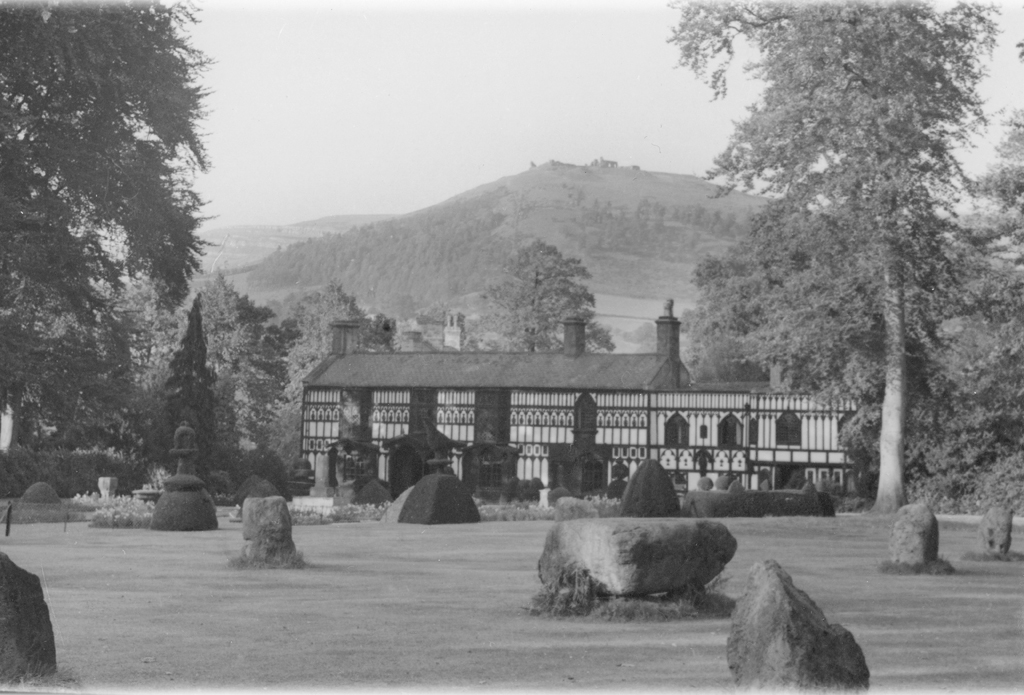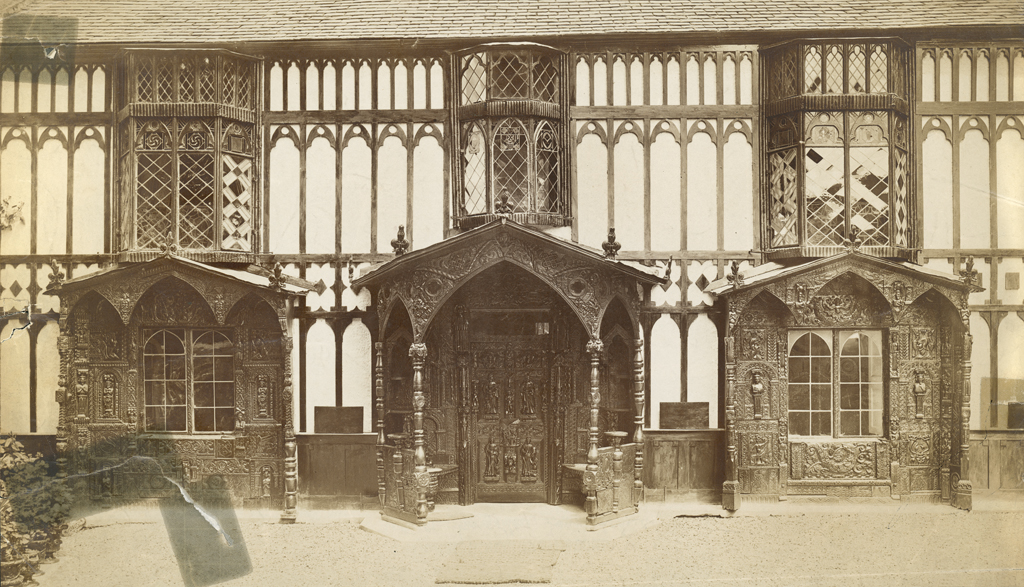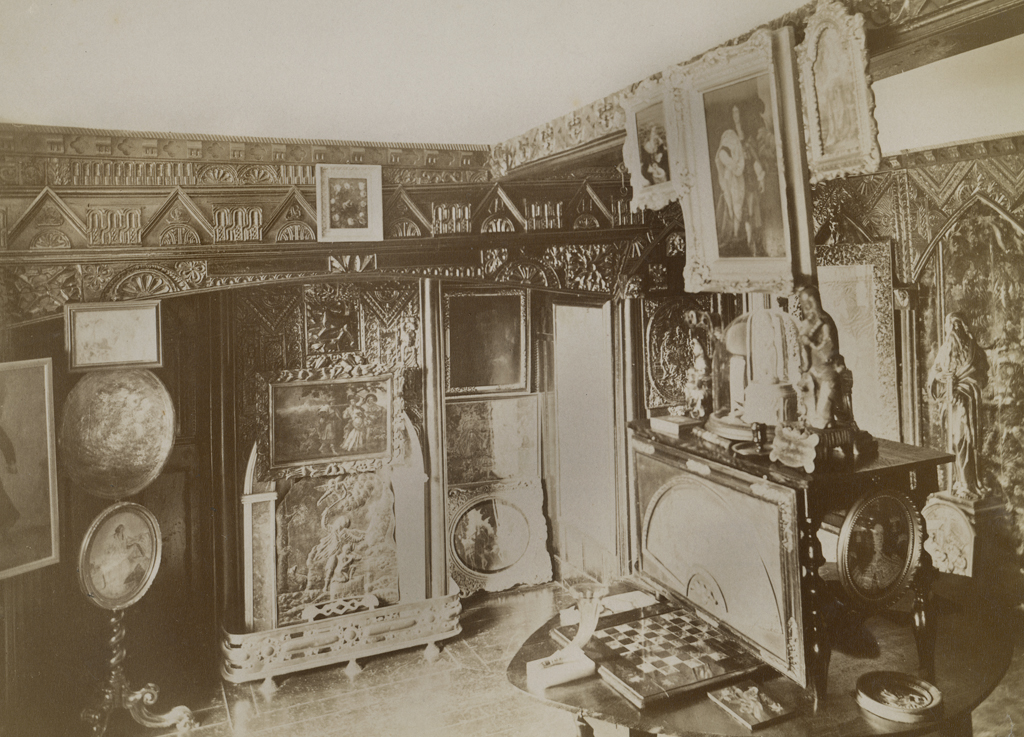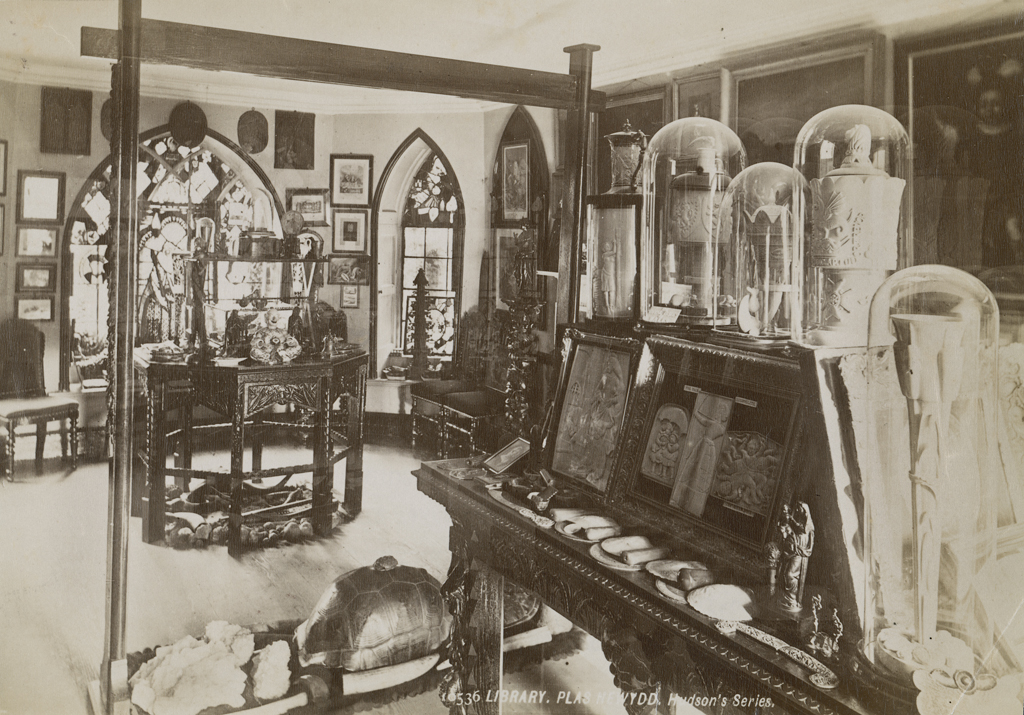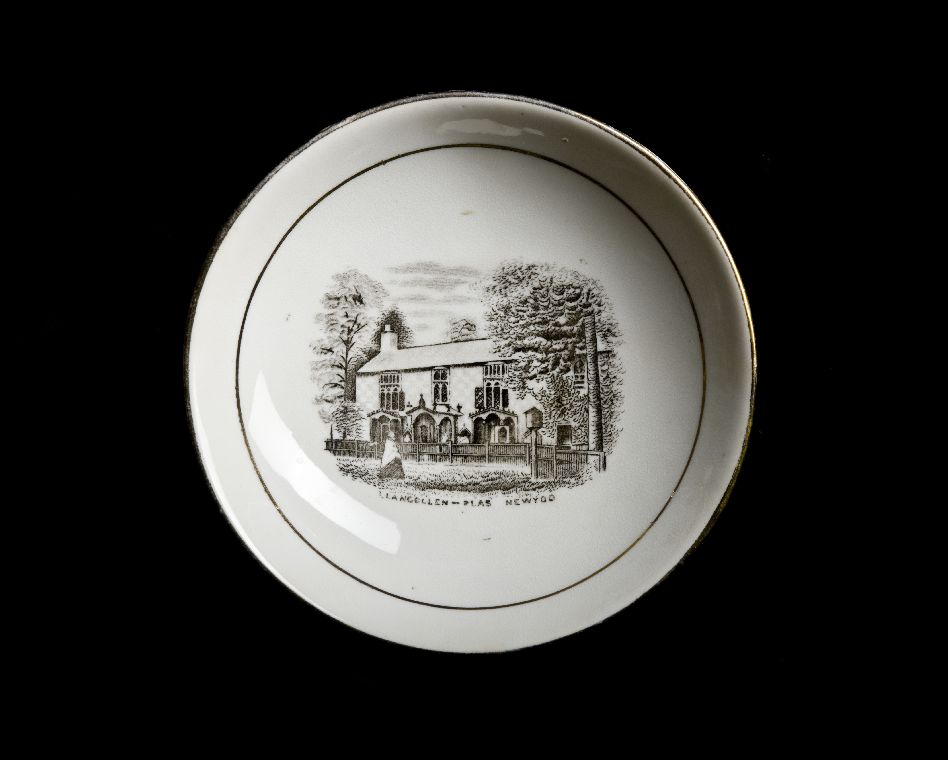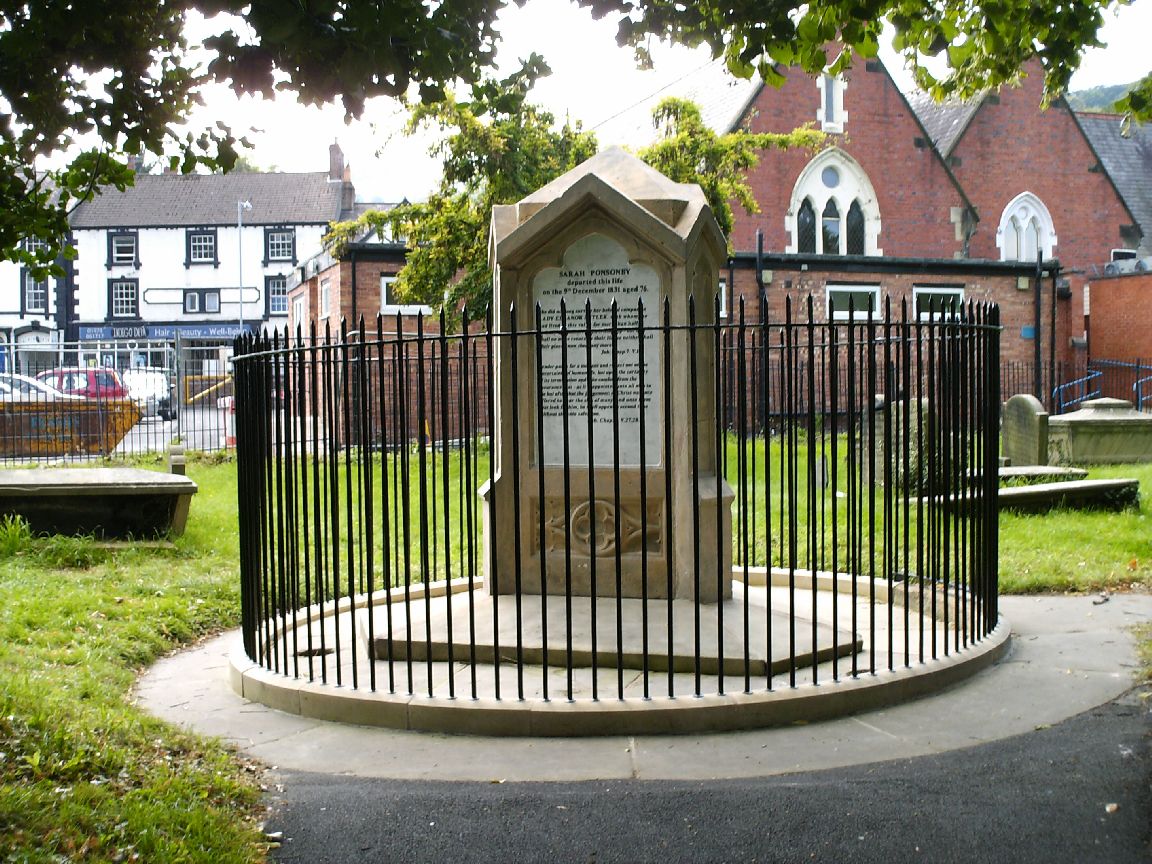Plas Newydd and the Ladies of Llangollen - Overview
This richly wood-ornamented house started life as a simple, two-storeyed, small stone cottage called Pen y Maes, signifying its location at the top of a field outside Llangollen. In 1778, the Ladies Sarah Ponsonby (1755-1831) and Eleanor Butler (1739-1829) rented the cottage and renamed it Plas Newydd.
Although they became well-known as the ‘Ladies of Llangollen’, Sarah and Eleanor were originally from Ireland. Following their first meeting in 1768, they formed a close relationship and made plans to escape their families. Their first attempt of a night-time elopement failed in 1778 when, dressed in men’s attire, armed with a gun and in the company of Eleanor’s maid Mary Carryll, they were intercepted at Waterford. As they vowed never to give up attempts to run away, their families begrudgingly gave in. After touring the north of Wales, the Ladies and their maid eventually settled at Plas Newydd, away from fashionable urban life.
With little money of their own, the Ladies largely depended on the good will and support of friends. Over time, they built up a library, undertook extensive correspondence and slowly refurbished and renovated their house and surrounding gardens. Plas Newydd was transformed in the Gothick style by installing arches, stained glass windows and ornate wood carvings, in addition to decorating their garden with the font from the nearby ruin of Valle Crucis Abbey.
Though they lived in relative isolation, the Ladies led a busy social life and were highly regarded among the villagers in Llangollen. As Llangollen lies on one of the earliest tourist routes in Wales, their growing international reputation began to draw more and more visitors to the house. In 1809, the French aristocrat and refugee Madame Genlis was kept awake at night by the Aeolian harp the Ladies had installed outside the window, and in 1828, the German Prince Pückler-Muskau spent an afternoon with them, having first heard about them as a child some thirty years before.
On her death in 1809, Mary Carryll bequeathed Aberadda field to the Ladies. Mary had bought the field with her life’s savings and the Ladies continued farming it to gain a small income. In return, the Ladies erected a memorial to her in Llangollen churchyard and were later interred in the same grave.
After their death, the house continued to be developed by later owners. General York added the applied black and white decoration to the façade, and the now demolished east and west wings were added.
Accounts of Travel
"Aus dem Berglande von Wales", c. 1900
Sophie Döhner (1844 – 1933)
Bei Llangollen bildet die Dee viel schäumende Wirbel und steigt über ein breites Wehr unterhalb der alten Brücke, die mit ihren vier spitzen Bogen zu den sieben Wundern von Wales gezählt wird. Ein sehr hübsches Bild bietet sich von dieser Brücke auf den kleinen Ort in seiner grünen Bergumgebung und die Ruinen des alten Schlosses von Dinas Bran auf hohem Felsenhügel. Zum Schluß suchte ich auf dem Kirchhof noch das Grab der berühmten Ladies of Llangollen auf. Es waren dies zwei irische Fräulein, eine Lady Butler und eine Miß Sarah Ponsonby, die innige Freundschaft geschlossen, sich ein jungfräuliches Leben gelobten und 1778 ihre Heimat heimlich verließen und sich erst nach Denbigh, dann hierher zurückzogen, wo sie noch fünfzig Jahre lebten. Lady Eleanor war siebzehn Jahre älter als Sarah, starb neunzig Jahre alt 1829, ihre Freundin folgte ihr 1831. Sie hatten eine treue Magd Mary Carryl, die mit ihren Ersparnissen das Freigut Plas Newydd für sie gekauft hatte und schon 1809 starb. Alle drei liegen in einem gemeinsamen Grabe und jede der drei Seiten des pyramidenförmigen Denksteins darüber ist mit seiner Inschrift einer von ihnen gewidmet. Ihr Haus, entzückend von außen, mit guten, alten, nur leider schwarz bemalten Holzschnitzereien geschmückt, in einem herrlichen Garten ist jetzt als Eigentum eines Liverpooler Herrn nicht mehr wie früher zu besichtigen ohne seine Erlaubnis ....
Near Llangollen, the river Dee produces many bubbling whirls and rises above a broad weir below the old bridge which, with its four pointed arches, is counted among the Seven Wonders of Wales. The bridge offers a lovely view of the town with its verdant hilly surroundings and of the old ruined castle Dinas Brân atop a lofty crag. At the end, I searched in the churchyard for the grave of the famed Ladies of Llangollen. These were two Irish spinsters, one Lady Butler and a Miss Sarah Ponsonby, who had formed a close friendship, vowed each other to lead maiden lives and secretly left their homeland in 1779, first to settle in Denbigh before retiring here, where they lived for another fifty years. Lady Eleanor was seventeen years older than Sarah and died at ninety years old in 1829; her friend followed her in 1831. They had a loyal maidservant in Mary Carryl who, with her savings, bought the freehold for Plas Newydd for them and who had died already in 1809. All three share one grave and each of the three sides of the pyramid-shaped memorial stone is dedicated on one of them. Their house, delightfully decorated on the outside with old but unfortunately black painted wooden carvings, and exquisite garden is now owned by a gentleman from Liverpool and can no longer be visited without his permission ....
Briefe eines Verstorbenen, 1828
Hermann von Pückler-Muskau (1785 – 1871)
Ich stieg aus, und wurde schon an der Treppe von beiden Damen empfangen. Glücklicherweise war ich bereits gehörig auf ihre Sonderbarkeiten vorbereitet, sonst hätte ich schwerlich gute contenance erhalten. Denke Dir also zwei Damen, wovon die älteste, Lady Elleonor, ein kleines rüstiges Mädchen, nun anfängt, ein wenig ihre Jahre zu fühlen, da sie eben 83 alt geworden ist; die andere aber, eine große und imponirende Gestalt, sich noch ganz jugendlich dünkt, da das hübsche Kind erst 74 zählt. Beide trugen ihr, noch recht volles Haar schlicht herabgekämmt und gepudert, einen runden Mannshut, ein Männerhalstuch und Weste, statt der inexpressibles aber einen kurzen jupon, nebst Stiefeln. Das Ganze bedeckte ein Kleid aus blauem Tuch von ganz besonderem Schnitt, die Mitte zwischen einem Männer-Ueberrock und einem weiblichen Reithabit haltend. Ueber dieses trug aber Lady Elleonor noch Erstens: den grand cordon des Ludwigsordens über den Leib, zweitens: denselben Orden um den Hals, drittens: abermals ditto das kleine Kreuz desselben im Knopfloch, et pour comble de gloire eine silberne Lilie von beinahe natürlicher Größe als Stern – alles, wie sie sagte, Geschenke der Bourbon‘schen Familie. So weit war das Ganze in der That höchst lächerlich, aber nun denke Dir auch beide Damen wieder mit der angenehmen aisance, und dem Tone der großen Welt de I’ancien regime, verbindlich und unterhaltend ohne alle Affectation, französisch wenigstens eben so gut sprechend, als irgend eine vornehme Engländerin meiner Bekanntschaft, und dabei von jenem wesentlich höflichen, unbefangenen, und ich möchte sagen, naiv heitern Wesen der guten Gesellschaft damaliger Zeit, das in unserm ernsten, industriellen Jahrhunderte des Geschäftslebens fast ganz zu Grabe gekragen worden zu seyn scheint, und mich bei diesen gutmüthigen Alten wahrhaft rührend ansprach. Auch konnte ich nicht ohne lebhafte Theilnahme die ununterbrochene und doch so ganz natürlich erscheinende zarte Rücksicht bemerken, mit der die Jüngere ihre schon etwas infirmere ältere Freundin behandelte, und jedem ihrer kleinen Bedürfnisse sorgsam zuvor kam. Dergleichen liegt mehr in der Art, wie es gethan wird, in scheinbar unbedeutenden Dingen, entgeht aber dem Gefühlvollen nicht.
... Nicht nur die ehrwürdigen Jungfern, auch ihr Häuschen war voller Interesse, ja mitunter enthielt es wahre Schätze. Keine merkwürdige Person fast, seit dem vergangenen halben Jahrhunderte, die ihnen nicht ein Portrait, oder andere Euriosa und Antiquitäten als Erinnerung zugeschickt hätte. Diese Sammlung, eine wohl garnirte Bibliothek, eine reizende Gegend, ein sorgenfreies, stets gleiches Leben, und innige Freund- und Gemeinschaft unter sich – dies sind alle ihre Lebensgüter; aber nach ihrem kräftigen Alter und ihrem heitern Gemüth zu schließen, müssen sie nicht so übel gewählt haben.
I alighted, and was received at the door by the two ladies. Fortunately, I was already prepared by hearsay for their peculiarities; I might otherwise have found it difficult to repress some expression of astonishment. Imagine two ladies, the eldest of whom, Lady Eleanor, a short robust woman, begins to feel her years a little, being now eighty-three; the other, a tall and imposing person, esteems herself still youthful, being only seventy-four. Both wore their still abundant hair combed straight back and powdered, a man’s round hat, a man’s cravat and waistcoat, but in the place of ’inexpressibles’, a short petticoat and boots: the whole covered by a coat of blue cloth, of a cut quite peculiar, – a sort of middle term between a man’s coat and a lady’s riding-habit. Over this, Lady Eleanor wore, first, the grand cordon of the order of St Louis across her shoulder; secondly, the same order around her neck; thirdly, the small cross of the same in her button-hole, and, ‘pour comble de gloire’, a golden lily of nearly the natural size, as a star, – all, as she said, presents of the Bourbon family. So far the whole effect was somewhat ludicrous. But now, you must imagine both ladies with that agreeable ‘usance’, that air of the world of the ‘ancien regime’, courteous and entertaining, without the slightest affectation; speaking French as well as any Englishwoman of my acquaintance; and, above all, with that essentially polite, unconstrained, and simply cheerful manner of the good society of that day, which, in our serious hard-working age of business, appears to be going to utter decay. I was really affected with a melancholy sort of pleasure in contemplating it in the persons of the amiable old ladies, who are among the last of its living representatives; nor could I witness without lively sympathy the uninterrupted, natural and affectionate attention with which the younger treated her somewhat infirmer friend, and anticipated all her wants. The charm of such actions lies chiefly in the manner in which they are per formed, – in things which appear small and insignificant, but which are never lost upon a susceptible heart.
... Not only the venerable ladies, but their house, was full of interest; indeed it contained some real treasures. There is scarcely a remarkable person of the last half century who has not sent them a portrait or some curiosity or antique as a token of remembrance. The collection of these, a well furnished library, a delightful situation, an equable, tranquil life, and perfect friendship and union, – these have been their possessions; and if we may judge by their robust old age and their cheerful temper, they have not chosen amiss.
(Tour in England, Ireland, and France, in the Years 1828 & 1829. With Remarks on the Manners and Customs of the Inhabitants, and Anecdotes of Distinguished Public Characters. In a Series of Letters. By a German Prince. Ed. B –. Vol. 1. London: Effingham Wilson, 1832)
Mémoires inédits sur le XVIIIe siècle et la Révolution française, c. 1790s
Stéphanie Félicité du Crest de Saint-Aubin, Comtesse de Genlis (1746 – 1830)
Une très-belle bibliothèque, composée d’excellens libres anglois, françois et italiens, étoit pour elles une source inépuisable d’amusements et d’occupations variées et solides car la lecture n’est véritablement profitable que l’orsqu’on a le temps de relire. L’intérieur de la maison étoit ravissant par la juste proportion et la distribution des pièces, l‘élégance des ornemens et des meubles et la vue admirable que l’on découvre de toutes les fenêtres. Le salon étoit décoré de paysages charmans, dessinés et peints d’après nature par miss Ponsonby. Lady Élénore étoit très-bonne musicienne; l’une et l’autre avoient rempli leur habitation solitaire de broderies d’un travail merveilleux ....
Le lendemain matin tout ce mystère fut éclairci. En ouvrant ma fenêtre je trouvai sur le balcon, une espèce d’instrument qui m’étoit inconnu, que l’on appelle en Angleterre une harpe éolienne; instrument inventé pour rendre harmonieux le vent, qui, lorsqu’il frappe ces instrumens produit en effet des sons ravissans. Il est assez naturel qu’un tel instrument ait été inventé dans une île orageuse au sein des tempêtes dont il adoucit la tristesse ....
Je me promenai toute la matinée avec les deux amies. Rien n’égale la beauté des sites qui environnent, et que domine la montagne, dont elles occupoient le sommet. Il sembloit, à cette élévation, qu’elles étoient les souveraines de toute cette belle contrée. Au nord elles avoient la vue du village et d’une forêt; au midi une longue rivière baigne le pied de la montagne, et fertilise l’immenses prairies, au delà des collines chargées d’arbres et de rochers./ Au milieu de ce séjour sauvage, s’élève une tour majestueuse qui paroît être le phare de ce rivage et qui n’est qu’un débris d’un château magnifique, habité jadis par le prince souverain du pays. Toute cette côte solitaire étoit jadis florissante et peuplée; elle étoit alors livrée à la seule nature, on n’y voyoit plus que des troupeaux de chèvres et quelques pâtre dispersés, assis sur les rochers, et jouant de la harpe irlandoise. En face de ce tableau agreste et mélancolique les deux amies avoient fait poser un siège de verdure, ombragé par deux peupliers; et c’étoit la, me dirent-elles, que souvent en été elles venoient relire les poésies d’Ossian.
A very beautiful library, consisting of excellent books in English, French at Italian, was for them an inexhaustible source of amusement and varied and serious occupations, because reading is not really profitable unless one has the time to re-read. The interior of the house was beautiful by the perfect proportions and the distribution of the rooms, the elegance of the ornaments and furniture and the admirable view that is to be discovered from each window. The drawing room was decorated with charming landscapes, drawn and painted from nature by Miss Ponsonby. Lady Elenor was a very good musician; they had both filled their solitary home with beautifully worked embroidery ....
The following morning [a] mystery became clear. On opening my window I found, on the balcony, a type of musical instrument that was unknown to me, and that is known in England as an aeolian harp; an instrument invented to make the wind harmonious so that when it hits, these instruments produce beautiful sounds. It is quite natural that such an instrument should have been invented on a tempestuous island at the heart of storms whose sadness they soften ....
I walked all morning with the two friends. Nothing is equal to the beauty of the sites that surround and that are dominated by the mountain on whose summit they live. It seemed, at this height, that they were sovereigns of the whole of this beautiful land. To the north they a view of the village and a forest; to the south a long river bathes the foot of the mountain and fertilizes vast meadows, beyond the hills covered in trees and rocks. In the middle of this wild place, a majestic tower rises, that looks like a lighthouse of the coast, but which is the remains of a magnificent castle, long ago occupied by the sovereign prince of the land. All this solitary coast was once a flourishing place full of people; now it had been given over to nature, and all that was to be seen were herds of goats and a some shepherds dotted about, sat on rocks, playing Irish harps. Facing this rustic and melancholic scene the two friends had placed a green seat, shaded by two poplars; and it was there, so they told me, that in summer they often came to re-read the poems of Ossian.
Voyage d’un Français en Angleterre pendant les années 1810 et 1811, 1810
Louis Simond (1767 – 1831)
Arrivés à la petite ville de Llangollen, deux milles au-delà, nous avons appris que l’hermitage fameux des deux amies, lady Eleanor Butler et miss Ponsonby était dans le voisinage, et après nous être informés de l’étiquette, nopus avong dépêché un billet pour demander la permission de voir le jardin (grounds), nous annonçant, dans la vue d’appuyer nos prétentions à cette faveur, comme des voyageurs américains. Les belles dames se sont montrées cruelles; il ne leur convenait pas de laisser voir leur habitation ce jour-là. La maîtresse de l’auberge, qui probablement nous avait entendu parler français, a remarqué que ces dames aimaient la langue française, et que si elles eussent su que nous la parlions, nous aurions été admis. L’avis était venu trop tard. Après dîner, nous nous sommes fait conduire près de l’hermitage, et nous en avons fait le tour. La maison, qui est sur un chemin public, n’a rien de remarquable: elle est en retard du bon goût des cottages, si universel aujourd’hui en Angleterre; et quant au jardin, qui est fort petit et que l’on voit presque en entier d’une hauteur qui le domine, nous n’avons pu rien y découvrir qui nous fit regretter de n’y avoir pas été admis. Un de nos prédécesseurs dans la carrière des voyages, et je crois que c’est madame de Genlis, en donne une description enchanteressse; mais pour nous les raisins nétaient pas mûrs. Le lecteur français désirera savoir quelque chose de ces dames. Il faut savoir que riches, belles et femmes de qualité, il leur vint, il y a un demi-siècle, l’idée romanesque de consacrer le reste de leur vie à la pure amitié; loin du monde et de ses vanités, de ses peines et de ses plaisirs. Se dérobant à leurs familles, elles s’enfuirent de l’Irlande, leur patrie, avec une fidèle gouvernante, qu’elles ont perdue tout récemment, et vinrent s’ensevelir dans la profonde solitude de cette vallée du pays de Galles. On dit qu’une inscription dans le jardin dévoile ainsi le secret de leur cœur:
Consacrer dans l’obscurité
Ses loisire à l’étude, à l’amitié sa vie,
Voilà des jours dignes d’envie.
Être chéri vaut mieux qu‘être vanté.
Near Llangollen, where we dined, is the residence of two ladies, whose names are identified with the vale, Lady E. Butler and Miss Ponsonby; and after having informed ourselbves of the etiquette of the place, we dispatched a note requesting permission to see the grouds, announcing ourselves, in hopes of strengthening our claim, as American travellers. The ladies, however, were cruel, and ansered, ‚it was not convenient to permit the place to be seen that day‘. The landlady, who had overheard some words of French spoken among us, observed that the ladies were fond of the French language, and that, if we had petitioned in French, we should have been admitted. The hint came too late.Taking a guide, however, we were conducted round the hermitage. The house is on a road; it is hight na narrow, and behind-hand in point of taste to the present style of elegant cottages. The garden is very small, an, from a height which overlooks it, we could see nothing to make us regret not having been admitted. A former tourist, (I believe Madame de Genlis), gives a charming description of it, but as to us, the grapes were sour. French readers may wish to learn something of these ladies. Their story is understood to be, that with birth, beauty, and fortune, they embraced, in the prime of their youths, half a century ago, the romantic idea of consecrating the remainder of their lives to pure friendship, far from the world, its vanities, its pleasures, and its pains; and, literally running away from their families in Ireland, with a faithful woman-servant, lately dead, they hid themselves in this then profound solitude, where they have lived ever since. The following inscription, I am informed, is placed in the garden:
Consacrer dans l’obscurité
Ses loisire à l’étude, à l’amitié sa vie,
Voilà des jours dignes d’envie.
Être chéri vaut mieux qu‘être vanté.
[translation: To devote, away from the light
Ones leisure to studying, and one’s life to friendship
Here are days worthy of envy/desire
To be cherished is better than to be praised.]
(Journal of a Tour and Residence in Great Britain, during the Years 1810 to 1811, by a French Traveller: with Remarks on the Country, Its Arts, Literature, and Politics, and on the Manners and Customs of Its Inhabitants. Edinburgh: Printed by George Ramsay and Co., for Archibald Constable and Co, 1815)
